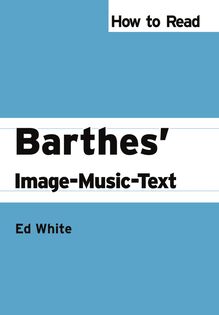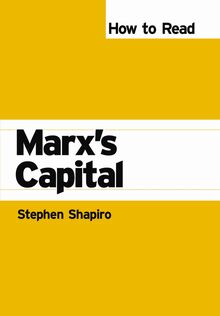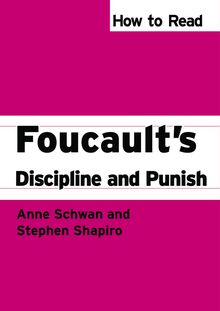-
 Univers
Univers
-
 Ebooks
Ebooks
-
 Livres audio
Livres audio
-
 Presse
Presse
-
 Podcasts
Podcasts
-
 BD
BD
-
 Documents
Documents
-
- Cours
- Révisions
- Ressources pédagogiques
- Sciences de l’éducation
- Manuels scolaires
- Langues
- Travaux de classe
- Annales de BEP
- Etudes supérieures
- Maternelle et primaire
- Fiches de lecture
- Orientation scolaire
- Méthodologie
- Corrigés de devoir
- Annales d’examens et concours
- Annales du bac
- Annales du brevet
- Rapports de stage
La lecture à portée de main
Vous pourrez modifier la taille du texte de cet ouvrage
Découvre YouScribe en t'inscrivant gratuitement
Je m'inscrisHow to Read Foucault's Discipline and Punish , livre ebook
Découvre YouScribe en t'inscrivant gratuitement
Je m'inscrisEn savoir plus
Vous pourrez modifier la taille du texte de cet ouvrage
En savoir plus

Description
Undergraduates across a wide range of disciplines are expected to have a solid understanding of Foucault's key terms, which have become commonplace in critical thinking today. While there are many texts that survey Foucault's thought, these are often more general overviews or biographical précis that give little in the way of robust explanation and discussion.
In contrast, Schwan and Shapiro take a plain-speaking, yet detailed, approach, specifically designed to give students a thorough understanding of one of the most influential texts in contemporary cultural theory.
Rationale
Overview
Note on Translation
Part One: Torture
1. The Body of the Condemned
2. The Spectacle of the Scaffold
Part Two: Punishment
1. Generalised Punishment
2. The Gentle Way in Punishment
Part Three: Discipline
1. Docile Bodies
2. The Means of Correct Training
3. Panopticism
Part Four: Prison
1. Complete and Austere Institutions
2. Illegalities and Delinquency
3. The Carceral
Suggestions for Further Reading
Index
Sujets
Informations
| Publié par | Pluto Press |
| Date de parution | 08 juillet 2011 |
| Nombre de lectures | 0 |
| EAN13 | 9781783710836 |
| Langue | English |
Informations légales : prix de location à la page 0,1248€. Cette information est donnée uniquement à titre indicatif conformément à la législation en vigueur.
Extrait
How to Read Foucault’s Discipline and Punish
How to Read Theory
Series Editors:
Stephen Shapiro, Department of English and Comparative Literary Studies, University of Warwick Ed White, Department of English, University of Florida
How to Read Theory is a new series of clear, introductory guides to critical theory and cultural studies classics designed to encourage readers to think independently. Each title focuses on a single, key text and concisely explains its arguments and significance, showing the contemporary relevance of theory and presenting difficult theoretical concepts in clear, jargon-free prose. Presented in a compact, user-friendly format, the How to Read Theory series is designed to appeal to students and to interested readers who are coming to these key texts for the first time.
Also available:
How to Read Marx’s Capital Stephen Shapiro
First published 2011 by Pluto Press 345 Archway Road, London N6 5AA
www.plutobooks.com
Distributed in the United States of America exclusively by Palgrave Macmillan, a division of St. Martin’s Press LLC, 175 Fifth Avenue, New York, NY 10010
Copyright © Anne Schwan and Stephen Shapiro 2011
The right of Anne Schwan and Stephen Shapiro to be identified as the authors of this work has been asserted by them in accordance with the Copyright, Designs and Patents Act 1988.
British Library Cataloguing in Publication Data A catalogue record for this book is available from the British Library
ISBN 978 0 7453 2981 9 Hardback ISBN 978 0 7453 2980 2 Paperback ISBN 978 1 7837 1083 6 ePub
Library of Congress Cataloging in Publication Data applied for
This book is printed on paper suitable for recycling and made from fully managed and sustained forest sources. Logging, pulping and manufacturing processes are expected to conform to the environmental standards of the country of origin.
10 9 8 7 6 5 4 3 2 1
Designed and produced for Pluto Press by Chase Publishing Services Ltd Typeset from disk by Stanford DTP Services, Northampton, England Simultaneously printed digitally by CPI Antony Rowe, Chippenham, UK and Edwards Bros in the United States of America
Contents
Rationale
Overview
Note on Text
PART ONE: TORTURE
1. The body of the condemned
2. The spectacle of the scaffold
PART TWO: PUNISHMENT
1. Generalized punishment
2. The gentle way in punishment
PART THREE: DISCIPLINE
1. Docile bodies
2. The means of correct training
3. Panopticism
PART FOUR: PRISON
1. Complete and austere institutions
2. Illegalities and delinquency
3. The carceral
Suggestions for Further Reading
Index
Rationale
Another book on Foucault? Michel Foucault (1926–1984) is one of the most internationally influential French scholars of the post-World War II period. Known primarily for his work on the mutually enabling relationship between knowledge and power and their use for social control, Foucault has been so influential in the English-speaking humanities and social sciences that it is barely possible to consider yourself a serious student in these fields without a working understanding of his writing, concepts and terminology. Whether contemporary writers strongly agree or disagree with Foucault, or fall somewhere in between, nearly all respond to his widespread influence, even if many are, at times, themselves unaware of their dependence on it. Consequently, the number of books and articles that try to explain, use or extend Foucault is very long indeed. Why then, is there any need, at this late date, for a reader’s guide to Foucault and one of his most-cited works, Discipline and Punish: Birth of the Prison (1975, English translation 1977)? The How to Read Theory series has as its overall motive to fill a gap for new readers of theoretical classics who have been disserved over recent years. As ‘theory’ has become more commonly used in the humanities and social sciences, students have been increasingly taught these writings through selected key passages of larger works, usually in specially designed anthologies. This strategy, however, denies those new to theory the chance to read critical arguments in their full context. Anthology readers lose the chance to see the process by which an argument is built up or how they might even respond to somewhat prefabricated snippets. If those hostile to the presence of theory often complain that many writers use certain theoretical words and phrases as if they were magic incantations that could simply be sprinkled, with mesmeric spirit, over an essay as if they were self-evident truths, the anthology approach is partially to blame, no matter how well-intentioned its editors.
How to Read Theory , on the other hand, believes that unfamiliar readers are best educated when they are helped to understand the whole trajectory of an important work by exploring its overall careful construction. Without this complete horizon, readers risk isolating bits of an argument and then misunderstanding what a much-studied writer is trying to say.
Nowhere is this error of incompleteness more common than with Foucault in general and in particular, Discipline and Punish , one of his most significant works. Precisely because Discipline and Punish has been so cited, a great deal of writing on it is unhelpful, since English-speaking readers, who have frequently relied on secondary explanations and anthologies, do not realize the limits and errors these create. We feel that readers who want to benefit fully from Foucault’s insights need to go back and read Discipline and Punish as a whole, paying attention to its actual claims and structure of argument, rather than the imaginary ones claimed for it. In particular, existing summaries of Discipline and Punish have been especially marred by three key absences, which we hope here to repair.
The first of these gaps is that abbreviated versions of Discipline and Punish lose sight that Discipline and Punish is above all a work of history emerging out of a particular French intellectual context. The book examines the strategy and tactics in punishment’s changing forms from the late seventeenth and early eighteenth century to the mid nineteenth (and beyond). Yet when Foucault published his work, there was still a large difference, if not mutual hostility, between the kinds of historical writing that were dominant in English-speaking lands and the ones by French scholars, who were challenging the themes and methods that Anglophone historians favoured. One feature of this split was the French scholars’ move away from defining history by great (usually) men and towards the study of a social history of anonymous or non-heroic figures, those often overlooked from academic perspectives, namely the working class and the poor, women, rural labourers, ‘deviants’ and criminals (these being overlapping categories). Another feature of the French historians was a declining commitment to relying on specific monumental dates, like those of battles, and towards longer periods of time, by taking several decades, or even centuries, as a single unit or by choosing dates that are not immediately dependent on the actions of a small group of elite historical figures. Even when Anglophone left and labour historians did begin to produce histories of the disempowered, they still tended to highlight ‘events’ rather than longer time-spans.
Because Foucault’s work falls generally within these French interests, his work was largely introduced into the United States and the United Kingdom by literature, rather than history, professors. While the former were more accepting of Foucault’s concerns, they were, conversely, often less interested in the historical phases that Foucault described and what helped create these changes. They focused instead mainly on the most recent historical phase that might be useful as a way to interpret modern literary and cultural affairs. By ignoring the several shifts between periods of time that Foucault describes, literary and cultural studies scholars lost sense of his claim about how modes of punishment carry meaning only in context of their own moment’s dominant features and tensions. Yet if we are not attentive to Foucault’s descriptions of ways in which Western societies developed into their modern forms, then we lose sight of both the present as a moment in an ongoing process and Foucault’s, admittedly often implicit, suggestions for how we might move beyond or escape this present. Furthermore, if readers only examine parts of Discipline and Punish , then they can easily experience Foucault’s vision as grim and lacking in change. Nothing could be further from the book’s message. Yet to uncover Foucault’s dedication to the possibility of a post-disciplinary society, we must pay close attention to his tale of passages through different historical moments to see what Foucault highlights as integral to the making of social change.
In one sense, Discipline and Punish appears easy to read. Large parts of the book are written with great style and draw on graphic, immediately understandable examples. Furthermore, the book is organized into parts and sections that make it easy to outline, especially as Foucault often numbers the points he wants to make. Additionally, Foucault is usually very careful to use his terminology in a precise and consistent fashion to differentiate the concepts he wants to illustrate. In another sense, though, Foucault can be an elusive writer to comprehend. This difficulty arises because Foucault was very much a member of the post-war French intellectual milieu. In the hothouse of universities located in and around Paris, academics were usually quite familiar with each other’s positions within a set of well-known theoretical debates. Because of this (at times suffocating) proximity, they were able to develop a writing style that signalled their own position with a few casual words.
For readers who are less familiar with this French academic environment and its
-
 Univers
Univers
-
 Ebooks
Ebooks
-
 Livres audio
Livres audio
-
 Presse
Presse
-
 Podcasts
Podcasts
-
 BD
BD
-
 Documents
Documents
-
Jeunesse
-
Littérature
-
Ressources professionnelles
-
Santé et bien-être
-
Savoirs
-
Education
-
Loisirs et hobbies
-
Art, musique et cinéma
-
Actualité et débat de société
-
Jeunesse
-
Littérature
-
Ressources professionnelles
-
Santé et bien-être
-
Savoirs
-
Education
-
Loisirs et hobbies
-
Art, musique et cinéma
-
Actualité et débat de société
-
Actualités
-
Lifestyle
-
Presse jeunesse
-
Presse professionnelle
-
Pratique
-
Presse sportive
-
Presse internationale
-
Culture & Médias
-
Action et Aventures
-
Science-fiction et Fantasy
-
Société
-
Jeunesse
-
Littérature
-
Ressources professionnelles
-
Santé et bien-être
-
Savoirs
-
Education
-
Loisirs et hobbies
-
Art, musique et cinéma
-
Actualité et débat de société
- Cours
- Révisions
- Ressources pédagogiques
- Sciences de l’éducation
- Manuels scolaires
- Langues
- Travaux de classe
- Annales de BEP
- Etudes supérieures
- Maternelle et primaire
- Fiches de lecture
- Orientation scolaire
- Méthodologie
- Corrigés de devoir
- Annales d’examens et concours
- Annales du bac
- Annales du brevet
- Rapports de stage








